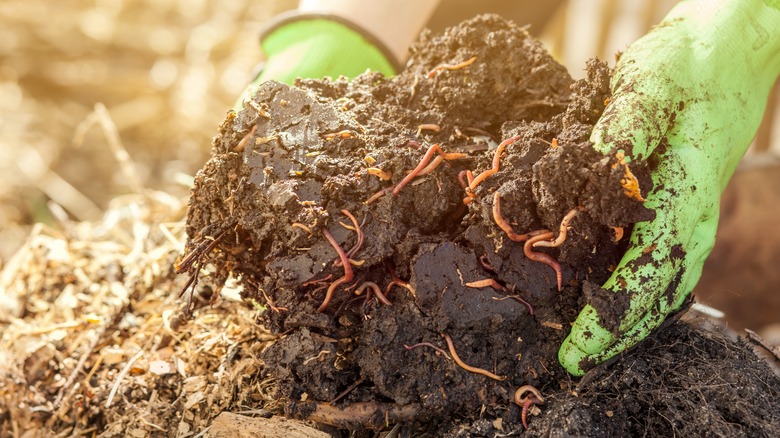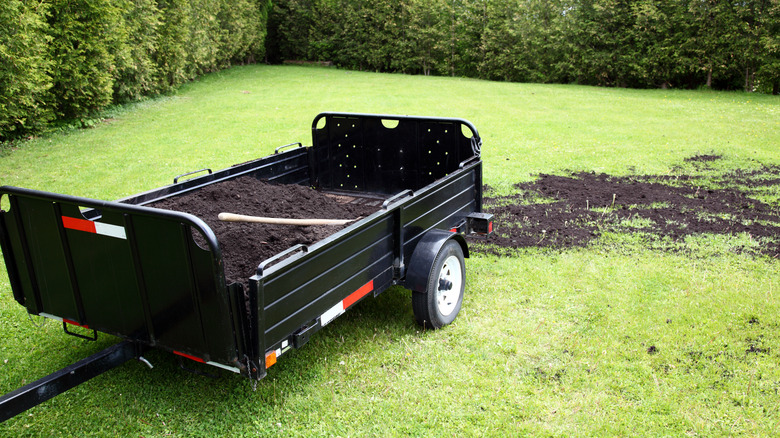For homeowners, fertilizing turf lawns is a common practice. However, in light of recent research (as noted by Scientific American) that shows just how damaging fertilizer runoff is to our waterways and local ecosystems, homeowners are making the switch to organic lawn care, and it’s long overdue. My name is Amira Gundel, and I’m the in-house horticulture and landscaping expert here at House Digest. With years of experience in sustainable landscaping practices, I’m going to let you in on some industry secrets when it comes to organically fertilizing your lawn.
The thing is, chemical fertilizers don’t even work as well in the long run and cause way more damage to our beloved planet than they do good for your lawn. The best fertilizer to use on your lawn, organic or otherwise, is a combination of topdressing with compost and adding worm tea to your lawn care maintenance routine. Organic methods for lawn maintenance work extraordinarily well because they focus on improving soil quality instead of treating the symptoms of poor soil quality. Organic and sustainable methods treat the root of the problem (pun intended). This results in the long-term health of your lawn, as opposed to short-term fixes that pollute our waterways and pale in comparison to the net benefits of utilizing organic methods.
What are compost and worm castings, and why do they work?

Compost is the result of a natural process that recycles organic matter — like food scraps, leaves, and other plant debris — into nutrient-rich and valuable fertilizer that helps foster healthy soils and, thus, healthy plants. Additionally, compost creates the perfect environment for healthy microbiology and fungi to reestablish in the soil, creating a living, breathing biome. Worm castings result from another kind of composting, vermicompost, made from the excretions of earthworms. Like compost, worm castings work the same way to increase the organic matter and microbiology in the soil.
Compost and worm castings provide vital nutrients that increase organic matter, bringing beneficial bacteria, microorganisms, and fungi that ultimately help improve soil structure. Organic fertilizers enhance the quality of soil, creating more complex soil webs and aeration by way of attracting earthworms and other beneficial bacteria. They also allow turf grass to grow robust root systems and improve the ability to uptake nutrients from the soil, strengthening the plant as a whole and reducing its susceptibility to pests. Think of organic matter in the soil as a storehouse of nutrients. Without soil health, turf grass will be chronically unhappy, leading to excessive fertilizer use that isn’t retained in the soil and washes into our waterways.
How to use compost or worm castings to naturally fertilize your lawn

The best way to use compost to fertilize your lawn is to topdress with it. However, if you are going to topdress, it’s best to aerate your lawn before or after to drive the compost into the soil and speed up the fertilizing process. You can either get a large compost delivery sent to your house for large applications or buy a few bags at the store, depending on your yard’s size. Additionally, you can always DIY your own compost. To use worm castings, you can also topdress the soil. However, the most common way to use worm castings for fertilizing your lawn is to make tea from it and spray down your yard using a pump sprayer.
You want to do one application in the spring and one in early fall. With organic fertilizers and lawn maintenance methods, timing is critical, as you’re working with the natural processes of the grass lifecycle instead of just blindly applying chemical fertilizers. Applying compost in the spring will help accelerate growth while turf grass is in the main growing stage. In the fall, putting down compost or spraying worm-casting tea will help your grass establish a deeper root system for the winter, inevitably leading to abundant and lush spring growth. Organic soil amendments and fertilizers help promote water retention, increase microbial diversity and health, and maintain consistent nutrient retention and cycling.